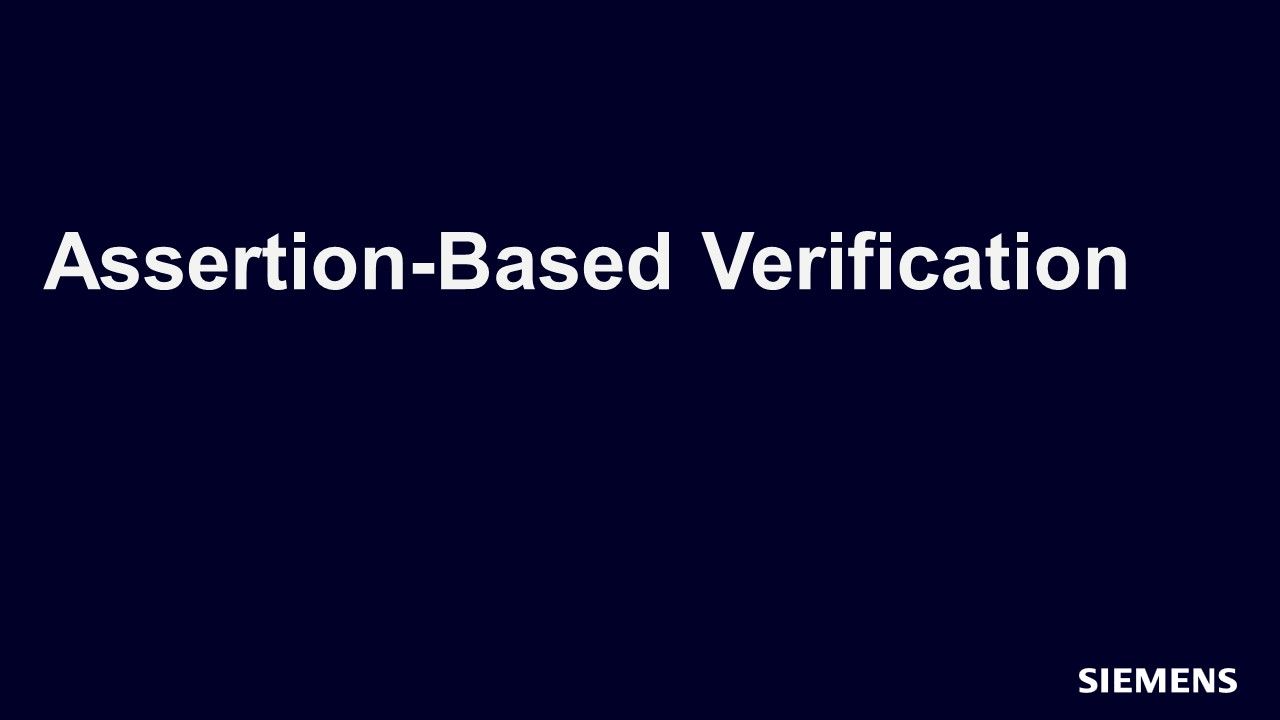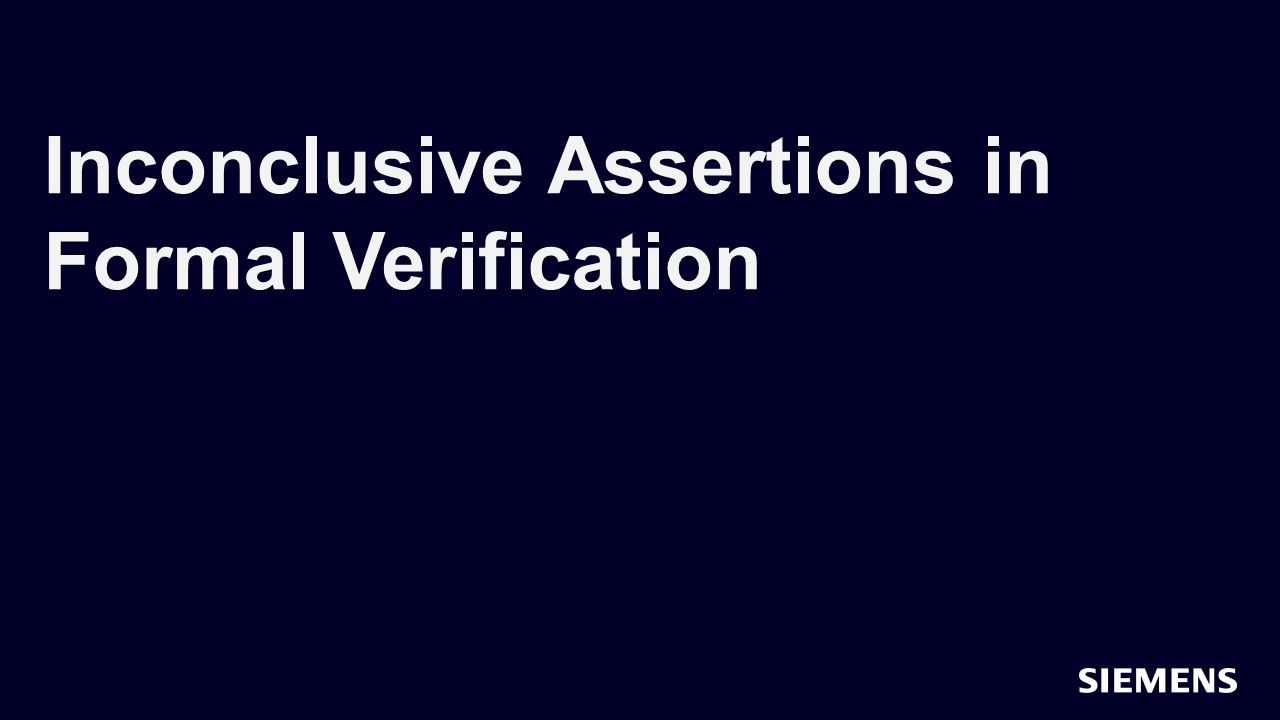Assertions
A verification engineer plays a critical role in the development of complex electronic systems, ensuring that these systems meet the desired functionality and adhere to the design specifications. One powerful tool in the verification engineer's arsenal is the use of assertions. Assertions are statements or properties embedded within the verification environment that help identify design bugs and verify the correctness of the system.
-

On-Demand
Generating SystemVerilog Assertion Properties with Property Assist
In this webinar, you will learn how Questa Property Assist automatically generates SystemVerilog Assertions (SVA) that describe the behavior of hardware designs, using AI technology. In addition, Property Assist turns user prompts into optimized LLM prompts, retrieves LLM provided solutions, and presents the best generated SVA solutions for the user.
-
Assertions Tracks
-

Assertion-Based Verification
This track introduces a set of steps for advancing an organization’s assertion-based-verification (ABV) skills, infrastructure, and metrics. -

Handling Inconclusive Assertions in Formal Verification
In this track, you will be introduced to techniques to help formal tools solve inconclusive assertions. You will also learn tool options to help convergence, introduce techniques for reducing assertion and design complexity.
-
-
Assertions Forum Discussion
-
Block Container
-
Content Block Container
-
Assertions Overview
The usage of assertions in functional verification is a crucial aspect of the verification process. Verification engineers have at their disposal several types of assertions, each serving unique purposes and complementing the overall verification strategy. In this comprehensive discussion, we will delve into the three main types of assertions: immediate assertions, temporal assertions, and functional coverage assertions, highlighting their significance in ensuring the reliability and quality of electronic systems.
Immediate assertions play a pivotal role in verifying the correctness of a design at specific moments during simulation. These assertions act as watchdogs, constantly monitoring the behavior of the design and immediately flagging any detected errors. One of the common syntaxes for immediate assertions is SystemVerilog's $assert, which allows verification engineers to define conditions that must hold true at a particular instant in time. Moreover, other programming languages like Python or C++ also offer assertion mechanisms, enabling cross-language support for this critical functionality.
The strategic placement of immediate assertions throughout the testbench is essential for thorough verification. By identifying potential issues as they occur, engineers can swiftly debug and rectify problems, ultimately saving time and effort during the verification process. Immediate assertions are particularly useful for catching corner-case scenarios and ensuring that the design behaves correctly under various conditions.
Moving on to temporal assertions, we encounter a powerful tool for specifying desired behavior over time. Unlike immediate assertions, which focus on the present moment, temporal assertions allow verification engineers to define properties that should hold true over a sequence of events or for a specific duration. This capability is particularly valuable when verifying complex protocols or systems where correct behavior spans multiple clock cycles or involves intricate timing interactions.
Two commonly used languages for expressing temporal assertions are SystemVerilog's Property Specification Language (PSL) and the Property Specification Language for Verification (PSLV). These languages provide a rich set of constructs to express complex timing relationships and temporal properties. Verification engineers can use temporal assertions to verify the sequential order of events, check for valid data transactions, and ensure the absence of race conditions, among many other use cases.
Incorporating temporal assertions into the verification process contributes significantly to design robustness and reliability. By thoroughly specifying timing requirements and expected behaviors, verification engineers can confidently ensure that the design meets all necessary specifications and operates correctly under various scenarios and environmental conditions.
Finally, functional coverage assertions offer a different perspective on verification, focusing on the completeness of the verification process rather than the correctness of individual design elements. These assertions aid in tracking the progress of verification by measuring how thoroughly specific aspects of the design have been exercised during simulation.
Functional coverage assertions monitor specific conditions or events and provide statistical feedback on how often these conditions occur during verification. This information is invaluable for verification engineers and project managers to assess the thoroughness of testing and identify any gaps in the verification process. By analyzing functional coverage data, teams can determine which areas of the design have been extensively verified and which may require additional testing to achieve sufficient coverage.
The implementation of functional coverage assertions is a proactive approach to verification, ensuring that all critical aspects of the design are adequately tested. Achieving high functional coverage is a strong indication that the design has been thoroughly exercised, which increases confidence in the final product's quality and robustness.
By combining immediate, temporal, and functional coverage assertions, a verification engineer can create a comprehensive and efficient verification environment. Assertions provide a systematic and automated approach to catching design bugs, ensuring correct system behavior, and measuring verification progress.
The importance of assertions extends beyond individual projects; it influences the entire electronics industry. As designs become increasingly complex, the reliance on assertions grows to maintain high verification productivity and quality. In turn, this helps companies meet market demands and deliver reliable products to customers.
The verification process is iterative, involving numerous cycles of testbench development, simulation, and debugging. Assertions provide a solid foundation for this process, enabling engineers to catch design bugs early on, reducing the time and effort needed for debugging. As a result, the verification process becomes more streamlined and efficient, ultimately leading to faster product development cycles.
Furthermore, the effectiveness of assertions extends beyond the verification phase. By catching design issues early, assertions also aid in reducing the overall development time. This time-saving is particularly critical in competitive industries where being the first to market can make a significant difference.
Moreover, the deployment of assertions enhances collaboration between design and verification teams. By defining clear specifications in the form of assertions, design and verification engineers can have a common understanding of the expected system behavior. This synergy streamlines communication and ensures that the verification process aligns with the design intent, leading to a more efficient and focused verification effort.
It is worth noting that the success of using assertions in verification heavily depends on the verification engineer's skill and expertise. Writing effective assertions requires a deep understanding of the design's functionality and the verification environment. A well-crafted assertion suite can significantly improve verification efficiency, while poorly formulated assertions may lead to false positives or negatives, leading to wasted effort in debugging irrelevant issues or overlooking critical errors.
As the electronics industry continues to evolve, the need for robust and efficient verification methodologies becomes increasingly vital. The complexity of designs grows exponentially with each technological advancement, and manual verification processes become insufficient and error-prone.
To address these challenges, advancements in assertion-based verification methodologies are continually being developed. Research in formal verification, constrained-random testing, and coverage-driven verification further enhances the capabilities of assertions in identifying and rectifying design issues. Furthermore, integration with sophisticated verification tools and platforms ensures seamless deployment of assertions in the verification process.
-
Assertions Conclusion
In conclusion, assertions play a pivotal and indispensable role in the realm of functional verification, renderingnumerous invaluable benefits to the electronics industry. The diverse array of assertion types, including immediate assertions, which promptly detect errors, temporal assertions, which verify time-related behaviors, and functional coverage assertions, which adeptly track verification progress, collectively establish a comprehensive and highly efficient verification environment.
By harnessing the formidable power of assertions, verification engineers can systematically detect and rectify design bugs, ensure the flawless operation of systems, and precisely gauge verification progress. The widespread adoption of assertions precipitates accelerated product development cycles, fosters enhanced collaboration between design and verification teams, and augments overall product quality and dependability, bestowing an unprecedented advantage to the electronics industry.
As the electronics industry continues its relentless march of progress, the significance of assertions will steadily amplify, guaranteeing that electronic systems consistently meet expected functionality and specifications. The continual advancements in assertion-based verification methodologies are poised to be the driving force propelling the industry forward, thus paving the way for the development of an impressive array of innovative and unswervingly reliable products, catering to a wide range of applications.
-
-